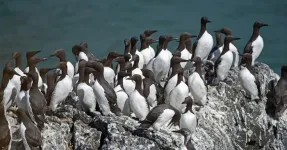(Press-News.org) In a Policy Forum, scientists discuss lifeforms composed of mirror-image biological molecules – also known as “mirror life” – and say creation of such lifeforms, which could evade immune mechanisms and predators, warrants careful consideration. The hallmark of mirror organisms is reversed chirality – a feature that would render them resistant to normal forms of biological degradation, making them useful for applications like long-lasting therapies. While these organisms haven’t yet been observed in nature, and the capability to create them is likely at least a decade away, requiring large investments and major technical advances, now is the moment, say the authors, to consider and preempt risks. The authors – an interdisciplinary researcher group, including researchers who have held the creation of mirror life as a long-term aspirational goal – call for broader discussion amongst the global research community, policymakers, research funders, industry, civil society, and the public, to chart an appropriate path forward. The detailed analysis on mirror life they present is perhaps the most comprehensive assessment to date. It qualitatively assesses the feasibility and risks of creating mirror bacteria, considering factors including the nature, magnitude, and likelihood of potential harms, the ease of accidental or deliberate misuse, and the effectiveness of potential countermeasures. The authors focus on mirror bacteria in this analysis but note that many of the considerations might also apply to other forms of mirror life. Among concerns, the authors say their analysis suggests that mirror bacteria would likely evade many immune mechanisms, potentially causing lethal infection in humans, animals, and plants. Such bacteria are likely to evade predation from phages and many other predators, facilitating spread in the environment. The authors explain that though they were initially skeptical that mirror bacteria could pose such major risks, they have since become deeply concerned. They call for additional scrutiny of their findings and further research to improve understanding of these risks. However, they note, in the absence of compelling evidence for reassurance, their view is that mirror bacteria and other mirror organisms should not be created. They believe that this can be ensured with minimal impact on beneficial research.
The findings of these researchers – summarized in the Policy Forum – are available in more detailed form in a separate, in-depth technical report that can be accessed at a link in the related press release.
END
Policy Forum: Considering risks of “mirror life” before it is created
Summary author: Meagan Phelan
2024-12-12
ELSE PRESS RELEASES FROM THIS DATE:
Breakthrough of the Year: A drug that prevents HIV infection, providing six months of protection per shot
2024-12-12
As its 2024 Breakthrough of The Year, Science has named the development of lenacapavir – a promising new injectable drug that prevents HIV infection. The award also recognizes related work surrounding gaining a new understanding of the structure and function of HIV’s capsid protein. Despite decades of advancements, HIV continues to infect more than a million people annually, with a vaccine remaining elusive. However, a new injectable drug, lenacapavir, offers hope by providing six ...
Heatwave led to catastrophic and persistent loss of Alaska’s dominant seabird
2024-12-12
The 2014-2016 Pacific marine heatwave wiped out more than half – roughly 4 million – of Alaska’s common murre (Uria aalge) seabirds, representing the largest documented vertebrate die-off linked to warming oceans, according to a new study. “Although research on the impacts of global warming on marine birds has clearly suggested major shifts in species’ ranges and abundance, documented changes have been gradual (years to decades),” write the authors. “To our knowledge, this study is the first to show that climate impacts can be swift (1 ...
Genomic analysis refines timing of Neandertal admixture – and its impact on modern humans
2024-12-12
A genomic study encompassing more than 300 genomes spanning the last 50,000 years has revealed how a single wave of Neandertal gene flow into early modern humans left an indelible mark on human evolution. Among other findings, the study reports that modern humans acquired several Neanderthal genes that ended up being advantageous to our lineage, including those involved in skin pigmentation, immune response, and metabolism. To date, sequencing of Neanderthal and Denisovan genomes has revealed substantial gene flow between these archaic hominins ...
Superflares once per century
2024-12-12
There is no question that the Sun is a temperamental star, as alone this year’s unusually strong solar storms prove. Some of them led to remarkable auroras even at low latitudes. But can our star become even more furious? Evidence of the most violent solar “tantrums” can be found in prehistoric tree trunks and in samples of millennia-old glacial ice. However, from these indirect sources, the frequency of superflares cannot be determined. And direct measurements of the amount of radiation reaching the Earth from the Sun have only been available since the ...
A new timeline for Neanderthal interbreeding with modern humans
2024-12-12
A new analysis of DNA from ancient modern humans (Homo sapiens) in Europe and Asia has determined, more precisely than ever, the time period during which Neanderthals interbred with modern humans, starting about 50,500 years ago and lasting about 7,000 years — until Neanderthals began to disappear.
That interbreeding left Eurasians with many genes inherited from our Neanderthal ancestors, which in total make up between 1% and 2% of our genomes today.
The genome-based estimate is consistent with archeological evidence that modern humans and Neanderthals lived side-by-side in Eurasia for between 6,000 and 7,000 years. The analysis, which involved present-day human genomes ...
New timeline for Neandertal gene flow event
2024-12-12
The study of ancient DNA has greatly advanced our knowledge of human evolution, including the discovery of gene flow from Neandertals into the common ancestors of modern humans. Neandertals and modern humans diverged about 500,000 years ago, with Neandertals living in Eurasia for the past 300,000 years. Then, sometime around 40,000 to 60,000 years ago, modern human groups left Africa and spread across Eurasia, encountering Neandertals along the way. As a result, most non-Africans harbor one to two percent ...
Your immune cells are what they eat
2024-12-12
LA JOLLA (December 12, 2024)—The decision between scrambled eggs or an apple for breakfast probably won’t make or break your day. However, for your cells, a decision between similar microscopic nutrients could determine their entire identity. If and how nutrient preference impacts cell identity has been a longstanding mystery for scientists—until a team of Salk Institute immunologists revealed a novel framework for the complicated relationship between nutrition and cell identity.
The answers came while the researchers ...
Oldest modern human genomes sequenced
2024-12-12
After modern humans left Africa, they met and interbred with Neandertals, resulting in around two to three percent Neandertal DNA that can be found in the genomes of all people outside Africa today. However, little is known about the genetics of these first pioneers in Europe and the timing of the Neandertal admixture with non-Africans.
A key site in Europe is Zlatý kůň in Czechia, where a complete skull from a single individual who lived around 45,000 years ago was discovered and previously ...
Diverse virus populations coexist on single strains of gut bacteria
2024-12-12
Viruses that infect and kill bacteria, called phages, hold promise as new treatment types for dangerous infections, including strains that have become resistant to antibiotics. Yet, virologists know little about how phages persist in the populations of bacterial cells they infect, hampering the development of phage therapies.
Published online December 13 in the journal Science, a new study offers the first evidence that a single bacterial species, the host of a phage, can maintain a diverse community of competing phage species. Led by researchers at NYU Grossman ...
Surveys show full scale of massive die-off of common murres following the ‘warm blob’ in the Pacific Ocean
2024-12-12
Murres, a common seabird, look a little like flying penguins. These stout, tuxedo-styled birds dive and swim in the ocean to eat small fish and then fly back to islands or coastal cliffs where they nest in large colonies. But their hardy physiques disguise how vulnerable these birds are to changing ocean conditions.
A University of Washington citizen science program — which trains coastal residents to search local beaches and document dead birds — has contributed to a new study, led by federal scientists, documenting the devastating effect of warming waters on common murres in Alaska.
In 2020, participants of the UW-led Coastal ...
LAST 30 PRESS RELEASES:
Tracing the quick synthesis of an industrially important catalyst
New software sheds light on cancer’s hidden genetic networks
UT Health San Antonio awarded $3 million in CPRIT grants to bolster cancer research and prevention efforts in South Texas
Third symposium spotlights global challenge of new contaminants in China’s fight against pollution
From straw to soil harmony: International team reveals how biochar supercharges carbon-smart farming
Myeloma: How AI is redrawing the map of cancer care
Manhattan E. Charurat, Ph.D., MHS invested as the Homer and Martha Gudelsky Distinguished Professor in Medicine at the University of Maryland School of Medicine
Insilico Medicine’s Pharma.AI Q4 Winter Launch Recap: Revolutionizing drug discovery with cutting-edge AI innovations, accelerating the path to pharmaceutical superintelligence
Nanoplastics have diet-dependent impacts on digestive system health
Brain neuron death occurs throughout life and increases with age, a natural human protein drug may halt neuron death in Alzheimer’s disease
SPIE and CLP announce the recipients of the 2025 Advanced Photonics Young Innovator Award
Lessons from the Caldor Fire’s Christmas Valley ‘Miracle’
Ant societies rose by trading individual protection for collective power
Research reveals how ancient viral DNA shapes early embryonic development
A molecular gatekeeper that controls protein synthesis
New ‘cloaking device’ concept to shield sensitive tech from magnetic fields
Researchers show impact of mountain building and climate change on alpine biodiversity
Study models the transition from Neanderthals to modern humans in Europe
University of Phoenix College of Doctoral Studies releases white paper on AI-driven skilling to reduce burnout and restore worker autonomy
AIs fail at the game of visual “telephone”
The levers for a sustainable food system
Potential changes in US homelessness by ending federal support for housing first programs
Vulnerability of large language models to prompt injection when providing medical advice
Researchers develop new system for high-energy-density, long-life, multi-electron transfer bromine-based flow batteries
Ending federal support for housing first programs could increase U.S. homelessness by 5% in one year, new JAMA study finds
New research uncovers molecular ‘safety switch’ shielding cancers from immune attack
Bacteria resisting viral infection can still sink carbon to ocean floor
Younger biological age may increase depression risk in older women during COVID-19
Bharat Innovates 2026 National Basecamp Showcases India’s Most Promising Deep-Tech Ventures
Here’s what determines whether your income level rises or falls
[Press-News.org] Policy Forum: Considering risks of “mirror life” before it is createdSummary author: Meagan Phelan





